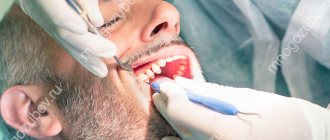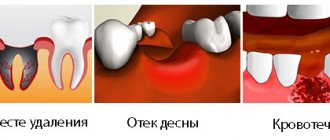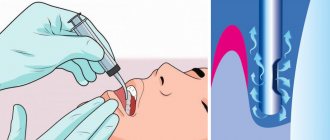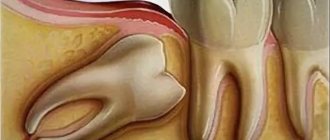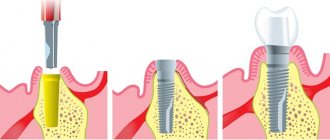Features of wound healing after tooth extraction
Before moving directly to hemostatic sponges, what they consist of and how to use them, you need to understand how the wound heals after removal and what can go wrong here. More on this later.
Why is there bleeding after removal?
Bleeding is a natural reaction to surgery. After all, when a tooth is removed, the smallest capillaries that penetrate the gums and ligamentous apparatus - the periodontium, which attaches the roots to the bone socket - are torn. And with difficult removal, the bleeding may be even stronger, because... The dentist makes incisions in the gums and drills into the jaw bone - the tissue is more damaged.
Bleeding is a natural reaction to surgery
Read on the topic: How long can a tooth hurt after extraction - normal and pathological.
How long does bleeding last normally?
Normally, the blood stops within 15-20 minutes (less often, within 45 minutes) and a blood clot forms in the socket. It seals the hole like a cork, preventing germs from penetrating inside. If the patient has problems that affect blood clotting, then the bleeding time is prolonged, and a clot may not form at all. And this is already fraught with inflammation of the bone socket (the pathology is called “alveolitis”). Therefore, according to indications, the dentist applies a hemostatic drug to the area of the extracted tooth.
On a note! Bleeding may appear again for a short time (and there will be quite a bit of blood) after the anesthetic wears off - if it contained adrenaline. This substance narrows the blood vessels in the intervention area, and as they expand normally, slight bleeding occurs. It goes away quickly.
Why does the bleeding not stop for a long time?
As a rule, after tooth extraction, the dentist says that you should not eat or drink for 2 hours. But few people say that you should not rinse your mouth or suck drinks out of a straw. In the first days, only oral baths are allowed, and it is better to drink in the usual way. Also, do not touch the wound with a brush. It is better to chew food on the healthy “side” of the jaw. Otherwise, there is a risk of moving or “pulling” the clot out of the hole - which will provoke new bleeding or even inflammation, which will result in long-term treatment.
The following groups of patients are also at risk:
- who has not formed a blood clot,
- with blood diseases,
- who takes blood clotting medications,
- having high blood pressure,
- women during menstruation or menopause,
- exposing themselves to physical activity immediately after removal and during the recovery process,
- if there was already inflammation at the extraction site (for example, pericoronitis above a wisdom tooth),
- during complex operations: when several teeth were removed at the same time, or manipulations were performed with increased tissue trauma.
Bleeding may occur during physical exertion after removal.
When you need urgent help
If the bleeding is profuse and does not stop for a long time, if after normalization of the condition the blood begins to ooze heavily again, this is a reason to consult a dentist. In a situation where the patient, in the presence of continuous bleeding, feels weakness, apathy, if the temperature has risen sharply (above 39 degrees Celsius), it is better to call an ambulance or go to the hospital on your own.
What is a hemostatic sponge
Now let's move on to why a hemostatic sponge is placed in the hole left after tooth extraction? Let's first understand the terminology. “Hemo” means “blood” and “stasis” means stopping. Those. a hemostatic sponge is needed to stop bleeding. In simple terms, this is a kind of replacement for a blood clot. The hemostatic sponge in the tooth socket not only seals the open cavity, but also has a hemostatic effect. Firstly, it puts pressure on small vessels, stopping bleeding. Secondly, it absorbs excess blood, increasing several times. The bleeding stops within 2-3 minutes.
On a note! By the way, local hemostatic agents are used not only in dentistry, but also in other areas of medicine - for example, hemostatic bandages successfully replace tourniquets that are applied for bleeding.
Hemostatic sponge
The detailed instructions indicate that this pharmaceutical product simultaneously combines the functions of a sorbent and an antiseptic and helps to avoid bacterial infection of open wounds.
The composition of this drug is natural, so the only contraindication for use is the body’s hypersensitivity to the active substances.
The mechanism of action of the hemostatic sponge is as follows: upon contact with the damaged surface, platelet adhesion and aggregation occurs, as a result of which bleeding stops.
In simple terms, a sponge helps to quickly stop bleeding in deep cuts and wounds, and prevent bacteria from entering the wound. This product is useful to have in your home medicine cabinet, especially if you have small children.
This product is also indispensable in travel and camping first aid kits, when a quick stop of bleeding may be urgently needed.
Appearance and release form
The hemostatic sponge looks like a cube or plate, which looks like a small sponge or a piece of yellow or white foam rubber. Although in fact it consists mainly of natural collagen with various medicinal additives. The plate is quite soft and easy to cut, which allows the dentist to cut the desired size according to the shape of the hole.
The plate is quite soft and easy to cut
Manufacturers produce both small (1x1 centimeter) and large sponges (10x10 cm). The plates are tightly sealed in transparent bags, and the cubes are sealed in dark, opaque bottles. Hemostatic powders and gels are also produced. Absolutely all collagen hemostatics dissolve on their own in the wound over time.
Types of hemostatic sponges
According to the manufacturing method, hemostatic sponges for teeth are of the following types:
- from donor blood plasma - amben,
- from bones/tendons/blood of cattle - collagen and gelatin.
You need to understand that a hemostatic agent not only stops bleeding (due to aminocaproic acid, for example) and stimulates the formation of a blood clot, but also has an antiseptic effect. It can also accelerate regeneration and relieve inflammation. It all depends on the active components that make up the hemostatic sponge. The drug can be impregnated with the following substances:
- antiseptics: chlorhexidine, furatsilin, silver suspension, boric acid, iodoform,
- local anesthetics: for example, lidocaine,
- preparations for bone regeneration: calcium phosphate,
- antibiotics: metronidazole, chloramphenicol, neomycin, gentamicin, etc.,
- natural substances: propolis, eugenol, etc.
Hemostatic sponges for teeth come in different types
Description of the drug “Hemostatic collagen sponge (hemostatic)”
Collagen hemostatic sponge is intended for use as a wound covering in surgery, traumatology, dermatology, dentistry and at home as a local hemostatic agent for bleeding.
The sponge has a local hemostatic and antiseptic effect, stimulates tissue regeneration.
The hemostatic sponge is a plate from yellow to brown in color, with a specific odor of acetic acid, with a porous structure, with a relief surface, absorbs liquid well, and swells slightly.
What is the hemostatic sponge made of?
The collagen hemostatic sponge is prepared from a collagen solution and is produced at two domestic enterprises.
The composition of hemostatic plates produced by JSC Luzhsky includes : collagen, boric acid and furatsilin.
The composition of the collagen sponge produced by Zelenaya Dubrava JSC includes: collagen no less than 80%, boric acid no less than 0.1%, aminocaproic acid no less than 1%, argovite no less than 0.01%.
Types of hemostatic sponges
According to the manufacturing method, hemostatic sponges are of the following types:
- from donor blood plasma - amben,
- from bones/tendons/blood of cattle - collagen and gelatin.
You need to understand that a hemostatic agent not only stops bleeding (due to aminocaproic acid, for example) and stimulates the formation of a blood clot, but also has an antiseptic effect. It can also accelerate regeneration and relieve inflammation. It all depends on the active components that make up the hemostatic sponge. The drug can be impregnated with the following substances:
- antiseptics: chlorhexidine, furatsilin, silver suspension, boric acid, iodoform,
- local anesthetics: for example, lidocaine,
- preparations for bone regeneration: calcium phosphate,
- antibiotics: metronidazole, chloramphenicol, neomycin, gentamicin, etc.,
- natural substances: propolis, eugenol, etc.
What size are hemostatic sponges?
The range of applications for hemostatic sponges is very wide, from dentistry to organ surgery. Sponges come in different sizes, you can choose one that is convenient for you or cut off a piece of the size you need.
Hemostatic plates are made in dimensions: 50x50x7 mm, 90x90x7 mm, 97x97x7 mm, diameter 11x7 (thickness) mm
Manufacturers of hemostatic sponges
Popular manufacturers of hemostatic agents used by dentists in our country are domestic companies. Let's consider them further:
- Alvostaz compress from Omega-Dent: available in the form of cubes, flagella, powders and solutions. The compresses are numbered - “1” with iodoform, “2” with metronidazole and chlorhexidine, “3” with neomycin and chloramphenicol,
- "Gemasept" with gentamicin from the Russian Research Institute of Hematology and Transfusiology of the Federal Medical and Biological Agency",
- “Collagen hemostatic sponge” with silver and boric acid from “Zelenaya Dubrava”,
- “Hemostatic sponge” with furatsilin and boric acid from “Belkozin”.
Indications for use
A hemostatic sponge can be useful after tooth extraction, especially wisdom teeth. Because the “eights” often do not erupt completely, and the dentist has to perform a mini-operation to get to them and remove them along with the roots. When a tooth is removed, a hemostatic agent is placed 3-4 months before implantation to completely eliminate the possibility of complications and problems with the formation of new bone in the socket.
Also, hemostatic sponges or powders are used during operations on the gums1 - plastic surgery, curettage of gum pockets (removal of deep “deposits” of tartar), and when cutting off dead areas of the jaw bone due to osteomyelitis. In the latter case, bone blocks and materials for regeneration of bone substance are additionally planted. In general, the doctor always assesses the patient’s condition in advance - asks about diseases and other conditions, and about the medications taken. If there is a risk of bleeding or poor regeneration, then rest assured, a hemostatic sponge will definitely be placed in the hole.
These sponges are used for bone augmentation
It is important to know! A few days after tooth extraction, it may be necessary to apply a hemostatic sponge if the dentist sees a tendency to worsen. For example, a clot has fallen out or the gums/bone have become inflamed.
Hemostatic sponge price
The specified drug is easy to find on the open market, but it is also easy to order via the Internet on thematic websites from detailed catalogs. In the latter case, it turns out to be somewhat cheaper, and delivery is not delayed. Before making such a relevant purchase for yourself, it is important to find out not how much the hemostatic sponge costs, but whether it is suitable for the patient’s specific clinical picture or not. If there are no medical contraindications for use, you can use reliable information from the table below with metropolitan prices:
| Name of pharmacy in Moscow | Cost of the drug 50X50 mm, rubles |
| ElixirPharm | 93 |
| EuroPharm | 95 |
| Ozerki | 60 |
| Rigla | 80 |
| Alexandrovskaya Pharmacy | 85 |
| Liquitoria | 90 |
| Pharmacy 36.6 | 83 |
How to use the drug correctly
How to use the sponge? The hemostatic sponge is placed into the socket of the extracted tooth only by the dentist. Home use is not recommended due to the risk of infection deep into the tissues. The application procedure is given step by step below:
- tooth extraction or treatment of the hole a few days after removal: in the latter case, purulent masses are removed, irrigation is carried out with an antiseptic,
- a piece of the hemostatic plate is cut off with sterile scissors or a hemostatic cube is taken with tweezers,
- the drug is placed in the hole and pressed with a flat instrument: if the hemostatic agent is pre-saturated with thrombin, the hemostatic effect is enhanced,
- if necessary, an additional piece of hemostatic is applied,
- if necessary, a small tampon is placed on top of the hole (it will be removed the next day),
- suturing the gums - a seam in the shape of the letter “P”: also, if necessary, in most cases you can do without stitches.
A piece of the hemostatic plate is cut with sterile scissors.
Hemostatic sponge - instructions for use
This medication is intended for external use to pack an open wound. The dry substance-solution is applied over the open wound, then wait a few minutes. During this time, the hemostatic sponge fills with blood and the bleeding stops. Its edges fit tightly to the wound, but for greater reliability it is better to use a second sponge on top of the first. When the hemorrhage has stopped, the treatment agent is fixed with a U-shaped suture and a bandage is applied. To enhance the effect, the sponge must be moistened with thrombin solution.
If you use a hemostatic sponge with Ambien, the rules for use are somewhat different. The contents of the bottle are intended for tamponing the cavity of an open wound, and the product itself must be held with a surgical instrument and a gauze swab for 5 minutes. You can leave a layer of gauze in the wound for a short period of time, but it must be removed the next day. A hemostatic sponge after tooth extraction is used exactly according to this principle. The attending physician will advise you on the correct choice of prescription and intensive therapy regimen.
- Loop symbols when knitting: how to read patterns
- Sea buckthorn - beneficial properties and contraindications for women and men. Benefits of sea buckthorn berries
- Shortbread cookie dough: recipes with photos
Side effects
Not all patients are allowed to stop bleeding using a hemostatic sponge, since side effects may occur in the form of allergic, local reactions on the skin. This is itching, burning, redness, increased swelling of the dermis. Therefore, if the body is hypersensitive to the active substances, it is better not to use the drug after surgery and during intensive care. In addition, doctors do not exclude the risk of secondary infection. Detailed instructions for using the hemostatic sponge do not report other side effects.
Contraindications
If the surface of the dermis is damaged, not all patients are allowed to use this inexpensive drug, since there are medical restrictions. For example, in case of arterial bleeding from large vessels after resection, it is better not to use a hemostatic sponge. This drug should be prescribed to a child with caution, but it is strictly prohibited if the body is hypersensitive to the active components. So dissolving the product in the cavity of an open wound does not help all patients, as stated in the detailed instructions.
Storage conditions
The sponge must be stored in a dry place, since with high humidity this medicine will soon become unusable. The instructions say that such a local antiseptic should not fall into the hands of children or be used for other purposes. Self-medication is possible, especially if you immediately need to stop heavy bleeding. There is an expiration date written on the packaging, which is also important not to violate, otherwise you may not get the desired result. The family first aid kit is the best place to store a hemostatic sponge.
Is it necessary to remove the hemostatic agent?
Patients often wonder what to do with a hemostatic sponge after it has been placed in the socket of an extracted tooth? How long should I keep it on, and will it dissolve on its own? The rules of conduct are as follows: carefully but thoroughly observe oral hygiene, and also take medications prescribed by the dentist. There is no need to specially remove the hemostatic agent - after all, it consists of components that will completely dissolve during wound healing. And instead of a hemostatic agent, its own tissues form in the hole.
“When my wisdom tooth was removed, they stuffed it into the wound like a piece of foam rubber. I then saw the houses through the seams. I was also surprised - what is it? And at the next appointment, my dentist told me that this is a special sponge that absorbs blood and protects against infection. And when it resolved, I didn’t even notice)) It probably completely disappeared in a couple of weeks.”
Ekaterina R., review from irecommend.com
Contraindications and side effects
The only contraindication to the use of a hemostatic sponge after tooth extraction is an individual allergy to any of the components of the drug. In particular, for antibiotics that are used to impregnate the hemostatic agent. Therefore, be sure to tell your dentist if you are allergic and to what medications. Hemostatic agents should also be used with extreme caution in children.
There are no side effects, because There are no toxic substances or components that affect perception in hemostatics. But if itching, inflammation, or swelling appears, feel free to contact your dentist. These manifestations can be caused either by a newly manifested allergy or by incipient complications - if, for example, the treatment was carried out poorly or the patient did not follow the doctor’s instructions.
1Skulean A. Periodontal regeneration, 2012.
How to use a hemostatic sponge
Immediately before use, observing the rules of asepsis, open the packaging with scissors.
- The plate is removed, applied to the bleeding area and pressed against it for 1-2 minutes, or the bleeding surface is tightly tamponed, followed by bandaging.
- After soaking in blood, the hemostatic plate fits tightly to the bleeding surface.
- If the bleeding does not stop, a second layer can be applied.
After the bleeding has stopped, the sponge is not removed, as it subsequently completely dissolves. The size and quantity of the hemostatic sponge are selected according to the size of the bleeding surface or the volume of the cavity.
Application in dentistry
The hemostatic agent is used topically for wound packing and has a wide range of actions, including:
- bleeding stop;
- protecting the wound from the development of bacterial infection;
- relief of foci of inflammation;
- relief from painful sensations;
- preventing swelling of the gum tissue;
- accelerating the healing of the hole.
The effect of the product continues for several hours after tooth extraction. After a certain time, the collagen sponge placed on the wound in the gum is completely absorbed.
